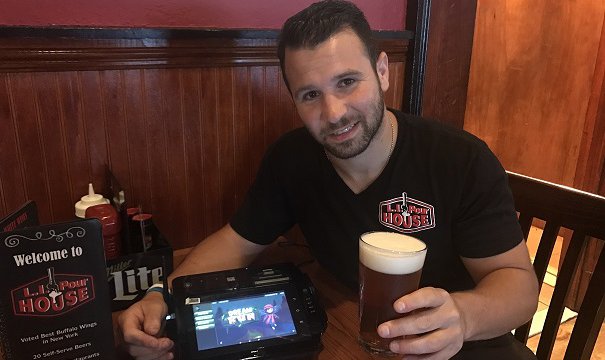Anthony Pallino is glad to have found a self-order kiosk that is cost efficient for his restaurant. Photo courtesy of LI Pour House Bar and Grill.
Self-order kiosks are one of the fastest growing technologies in the restaurant industry today, with several of the nation’s leading chains deploying these customer conveniences. While the big chains move forward on this front, will independents and chains that are not as well capitalized as their larger competitors be left behind?
LI Pour House Bar and Grill, a fast casual independent in Port Jefferson Station, New York, recently deployed self-order tabletop kiosks on all of its tables and has found the convenience very popular with customers. Customers can order and pay when they want. Owner Anthony Pallino found what he considers an affordable kiosk that has proved reliable and has improved sales and made his operation more efficient.
Three months ago, Pallino installed a newly introduced kiosk from Juke Slot that does not require a high level of programming savvy. Updates to product descriptions, images and menu color schemes can be made in real time.
Long Island’s first self-serve restaurant
For Pallino, the self-order tabletop kiosk was a natural extension to the self-serve craft “beer wall” the restaurant featured when it opened three years ago. The “iPourIt” technology allows customers to select from a line of wall-mounted beer taps to pour themselves beer. Customers get a radio frequency identification wristband that tracks who is pouring their beer and automatically calculates their tab.
“I wanted to become Long Island’s first self-serve restaurant,” Pallino told Kiosk Marketplace. “We just wanted to be able to capture the culture of being self-serve. Who wants to sit there and wait for a beer for 15 minutes?”
The success of the “beer wall” encouraged Pallino to extend self-service to food orders. After researching various self-serve restaurant kiosks, he opted to go with a recently introduced model from Juke Slot that is specifically designed for small restaurants. He was initially attracted to the kiosk’s aesthetic appearance, describing it as sleek and “new age.”
Pallino also liked the flexibility the system offers to make text and graphic changes.
“We’re constantly changing things; we’re constantly doing specials,” he said.
Step 1: due diligence
In the process of doing his due diligence, Pallino checked with an existing Juke Slot customer who told him the system delivered higher check averages.
He also checked with the owner of a restaurant using a different kiosk system who told him there were issues changing the menu.
“One thing that enticed me the most was being able to grow with the company together, as we are ourselves a growing company,” Pallino said. Juke Slot is one of the newer players in the kiosk market.
“They’re going to stay hungry; they’re a brand new company, they’re not going to become complacent, they’re going to constantly try to evolve,” Pallino said. “I felt more comfortable with them than I did with anybody else.”
28 kiosks installed
Pallino now has Juke Slot tabletop kiosks at all 24 tables, and four near the bar. The tabletop units are 5 by 8 inches and have 7-inch monitor screens.
Pallino estimated the hardware for his 28 kiosks was $30,000. In addition to this one-time cost, he pays Juke Slot $399 per month for the kiosk service, including the credit card processing.
Once a customer places an order on the kiosk, the order gets sent to the kitchen where it appears on a screen for the kitchen staff to prepare.
The servers were initially skeptical about the self-order kiosks, Pallino said, but it didn’t take long for this to change. He told them that the kiosks would give them a chance to give them more time to interact with customers.
So far it has paid off, as the average check has increased from $20 to $22, and server tips are higher.
“They (the servers) told me they’re making a little more money,” he said. “I chalk that up to them being able to give more of their personality. Atmosphere is created by the personality. It’s a little more relaxed atmosphere now.”
One reason for the check increase is the kiosk automatically suggests additional purchases, Pallino said. While he trains his servers to suggest additional purchases, they don’t always remember to do so.
When the customer pays, the kiosk gives a choice of 10, 15 and 18 percent tips, and more if they wish.
The kiosk also offers games, which keeps children occupied.
Pallino estimated that about 70 percent of the customers use the kiosk to place orders. He suspects the usage is higher in his restaurant than some because his median age is 32.
A unique kiosk offering
Jegil Dugger, sales and operations manager at Juke Slot, claims the kiosk, called Do It Yourself, has more flexibility in making changes to a menu than other self-order kiosks. The kiosk can be free-standing or tabletop.
The Juke Slot system includes its own back-end software, Dugger said, although the kiosk can integrate with other back-end software systems.
Juke Slot’s goal in developing the Do It Yourself unit was to enable smaller restaurants like LI Pour House Bar and Grill to offer customers the same convenience that the large chains are introducing.
Dugger said Juke Slot offers companies the option of having the hardware and software combined into a monthly cost, so there is no upfront hardware investment.
“The problem these restaurants are facing is they don’t have the budget to be able to spit out $500,000 or millions of dollars like McDonald’s and some of these bigger franchises,” Dugger said.
Self-order kiosks are proving convenient for customers and allowing restaurants to serve customers faster. The benefits hold true for restaurants of all sizes. Kiosk manufacturers are not ignoring the small, independent restaurants.
by Elliot Maras

